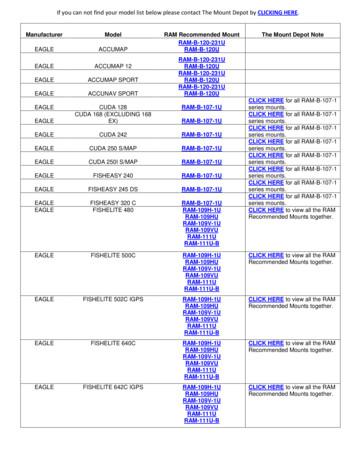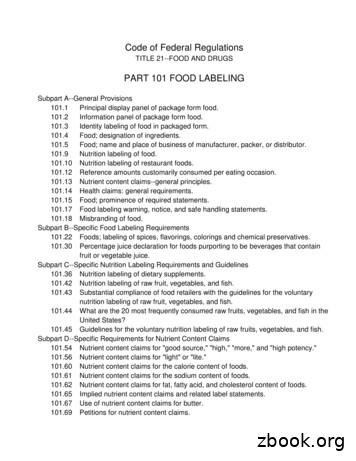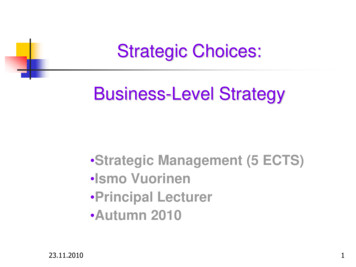Grant Writing 101: Securing Funding For Animal Care
Grant Writing 101:Securing Funding for AnimalCareAdam LieblingASPCADirector of Grant Compliance& Communicationadam.liebling@aspca.org
Agenda Barriers to GrantseekingPreparing to ApplyGrant Proposal TipsInitiating & MaintainingConnectionsTips for Securing Funding forAnimal Seizure & CareSample Online ApplicationProcessQ&A
Perceived GrantseekingBarriersPerception #1: “In general, the odds of getting a grant are slim.”Last year, the success rate for applying to the ASPCA was 64%
Perceived GrantseekingBarriersPerception #2: “We’re too small to get a grant.”Last year, 74% grantees had budgets under 1MOf those orgs, 44% had budgets of under 100K)
Perceived GrantseekingBarriersPerception #3: “We’re too remote / we’re not nearby /it’s all about who you know.”Last year, the ASPCA provided nearly 17.5 million to more than 1,100organizations in all 50 states, DC, PR, and U.S. territories“More than 3,000 animalwelfare organizationspartner with PetSmartCharities to save morelives every day.”
Perceived GrantseekingBarriersPerception #4: “We’re too busy saving lives” and/or“Grant writing is burdensome” If you prepare, it takes less time and effort There is a movement toward application streamlining(projectstreamline.org) Grantseeking can be cost-effective compared to other types offundraising Grants help you save lives!
Perceived GrantseekingBarriersPerception #5: “We need general operating support”and/or “We need capital project funding”Grants can cover your program work so that other funds can beused toward general operations or capital projects
The Grantseeking MindsetWhat’s different aboutgrants from other types offunding? Typically relationships - often resulting inresidual benefitsThink in terms of projects, goals,and partnerships!
The Grantseeking MindsetOrganizational factors toconsider when applying fora grant Financial strength and stabilityCapacity to successfully carryout grant-supported workSuccessful track record andcurrent strengthsIt’s not about what you need, but about what you can do!Emphasize your strengths. Funders like to back a winner.
Grant Programs and Requestsfor Proposals (RFPs)Grant RFPs/websites generallyinclude: Program/RFP summary andfundable projectso What are they looking for?o What are the funder’sgoals? Organizational eligibilityo What type of org? Aremunicipalities included? Award range or maximumo What is the funding limit? Application deadlineo What time and time zone?Does 12 midnight mean daybefore or day of? Review/approval processo When will I hear back? Contact informationo Who can I contact withprogrammatic oradministrative questions? Grant history/databaseo Which orgs and projectssuccessfully got funded?
RFPsSolicited vs. Unsolicited Unsolicited / Open Any eligible applicant may apply Solicited / Invited Funder approaches YOU to submita proposal and/or guides you on your proposalsubmission Letter of Inquiry/Letter of Interest (LOI) Open firststage for screening; only those invited to the next stagecan apply
Learning About RFPs Bookmark funders’ sites – visit them periodically Sign up for funders’ mailing lists ande-newsletters Follow funders’ Facebook pages/Twitter feeds Visit sites that announce RFPs, sign upfor alerts
RFP ntmakers.orgTheLionsShareBlog.com
Learning about RFPshttp://philanthropynewsdigest.org/rfps
Learning about RFPs
Learning about RFPs
Preparing to ApplyLook for shared priorities
Preparing to Apply but try to avoid this:
Preparing to ApplyGet organized: Note & build in lead timefor application deadlines Loop in the right peoplewhose info or approvalsmight be needed (ED?Accountant? Boardmember?)Put deadlines in Outlookwith remindersApply earlier than later
Preparing to Apply Gather commonly requested application data,stats, & documents Employer Identification Number (EIN)Form 990, financial statements, annual reports,operating budgetIRS Letter of DeterminationList of board members & senior staffAnnual intake & final disposition #’s by speciesStore these items in electronic foldersUpdate your org’s Guidestar profile
Submitting a CompleteApplicationFunders need details to evaluate your requestDetailed project description: What do you need the grantfunding for? Who will benefit? Why are you doing it? How and where will you do it? When and for how long?
Submitting a CompleteApplicationPrepare and present a solid budget Make sure the amount you’rerequesting isn’t too high or too low.Provide detailed breakdown ofproject costsProvide a clear explanation andjustification for each line itemBe prepared to list grants from otherfunders
Grant Proposal TipsBe compelling Link your project to anurgent need- Contextualize the “ask” withbackground statistics- Explain what differentiatesyour organization from others- Describe how the projectimpacts the larger community Consider long-term impact
Grant Proposal TipsThink like the funderIf you were in the funder’s shoes,what would you want to knowfrom the grantee?- If the request is for a vehicle, have youconsidered additional fuel, insurance, driver,storage, other staff? Will it be usedregularly?- If the request is for transport, do youalready have collaborators lined up?- How will the project keep going once thegrant period ends?
Grant Proposal TipsDescribe how you will evaluate your project What are you trying to changewith your project? What quantitative and qualitativedata can you collect? Who will collect and analyze thedata and what tools will theyneed? What indicators will tell you thatthe project has succeeded?
Grant Proposal TipsBe precise and polished Grammar/punctuation/spelling/CAPS – professionalism is important! Provide the pertinent details clearlyand concisely – avoid jargon Answer all questions Have someone review yourapplication before you hit “Submit”
The Foundation Center’s GrantSpace.org
The Foundation Center’s GrantSpace.org
#1 Secret IngredientTreat your grant application like a job interview. Be prepared – show that you did your homeworkBe professional – show that you would be a responsiblestewardBe patient – the application process can take weeks, evenmonthsBe gracious – avoid taking rejection personallyBrush up on technical skills – most applications areonline nowProvide references – other funders, grantees,veterinarian, etc. (Make sure to talk with them first!)Manage your online image – update website; Googleyourself!
Common Reasons forDeclination Lack of clarity or details Wrong application (read guidelinescarefully!) Multiple requests in one application Request is outside of fundingpriorities Organization owes overdue reports A declination of a grant request isnot a rejection of your organization.
Making Connections Conferences & networking!! Take leadership role in your local/regional network TIP: Do research before networking events &conferences Demonstrate connections and collaboration Even if there isn’t a funding fit, the connection can giveyou leads
Making ConnectionsBe Careful Don’t put funder on your mailing list unless theyencourage or request it Exercise judgment about LinkedIn, Facebook friendrequests for individuals Find out who you need to talk to; avoid spamminganyone & everyone Demonstrate connections, but name-dropping canbackfire Cold calling not a good idea
Maintaining the Relationship Thank you notes are always appreciatedComply with reporting requirements Put effort into quantitative & qualitativeoutcomes“Happy tail” stories and photos go a long wayIf successful, follow up to inquire aboutrenewal funding
Maintaining the Relationship Get in touch periodically Specifically, when there is big news to report (bigoutcome, surprising progress, impressive mediacoverage, etc.) Don’t bombard funders with emails Invitations to events/galas are generally ok Funders tend to prefer emails to phone calls Encourage site visits – invite your funder! Recognize the funder on your website and through socialmedia, press releases, events, and other publicity
Tips for Grants for AnimalSeizure & Care CostsPreparation is everything Know your funders and make connections beforehandHave background info ready (990, EIN, stats)Know your capacity and estimated costs, includingveterinarian & third party costsTrack already incurred costs and come up with budget forlength of time you will be holding animals (consider averagelength of time before trial or forfeiture hearing)Any legal issues that might arise when holding seizedanimals: What can be shared with funder? Which details aresensitive? Can photos be shared?Any public information that can bolster your request? (newsarticles and clips)
Who Supports AnimalSeizure Care & Prosecution?ASPCA – aspcapro.org/grants Animal cruelty investigation programsLarge-scale seizures (Puppy Mills, Hoarding, Animal Fighting)Expenses incurred as a result of cruelty seizures, such as veterinarycare, housing, transport, spay/neuter and placement.Outreach programs aimed at preventing or eliminating animal crueltyPetSmart Charities – petsmartcharities.org Emergency Relief Grants – includes rescues from hoarders and puppymills, and victims of crueltyThey also provide in-kind pet suppliesIan Somerhalder Foundation – isfoundation.org 2,500 grants for emergency medical care of abuse/neglect victims
Who Supports AnimalSeizure Care & Prosecution?Animal Legal Defense Fund – aldf.orgCriminal Justice Program Free legal assistance to prosecutors, investigators, and veterinaryprofessionals; legal research; strategy suggestions; location of expertwitnesses; amicus briefs; trainingALDF Litigation Program Awards monetary grants to assist attorneys with animal-related casesHumane Society of the United States –humanesociety.org Resources for prosecutors: legal research and writing; expert witnessand testimony; media assistance; amicus briefs; prosecutor training
ASPCA Proposal Process1. Goto ASPCApro.org/grants
2. Read through the guidelines and restrictions
3. Review specificgrant program fundingcriteria to determinebest fit
4. * Click on application link* Log into or create your account* Complete all required fields* Upload relevant attachments* Submit your application (applicationprocess is paperless)
But also made possible by you!Questions? Grants@aspca.org
Resourceswww.ndaa.org/animal abuse training webinars.html Register for additional webinars in the series Links to archived webinar recordings Download presentation slides and bonus materialsNext Webinar in Prosecuting Abuse Series:Collaborative Animal Cruelty InvestigationsThursday October 16, 3-4 pm ETHumane Society of the Pikes Peak Region, Colorado
Each Guidebook is 80 pagesFree Download atwww.ndaa.org/animal abuse newsletter mailinglist.html
National Coalition on ViolenceAgainst AnimalsJoin as an agency or individual for free!www.ncovaa.org
National Law EnforcementCenter for Animal Abuse Established by the National Sheriffs’ Association toprovide law enforcement officers information on therealities of animal abuse, and to promote theirproactive involvement in the enforcement of animalabuse laws in their communities.Through our partners, serves as an informationclearinghouse and forum for law enforcement on thegrowing problem of animal abuse, its link to other typesof crimes, including violence against humans andofficer-dog l-law-enforcement-center-animal-abuse
For resources, newsletter andwebinar information Allie PhillipsDirector, National Center forProsecution of Animal AbuseDeputy Director, National Center forProsecution of Child AbuseNational District Attorneys Association99 Canal Center Plaza, Suite 330Alexandria, VA 22314aphillips@ndaa.org703-519-1674
Watch this webinar recording anytime!Information applicable to any kind of animalwelfare agencywww.ASPCApro.org/webinarsGrant Resources for Equine Rescue
Grant Writing 101: Securing Funding for Animal Care Adam Liebling ASPCA. . Treat your grant application like a job interview. Common Reasons for Declination Lack of clarity or details Wrong application (read guid
Verkehrszeichen in Deutschland 05 101 Gefahrstelle 101-10* Flugbetrieb 101-11* Fußgängerüberweg 101-12* Viehtrieb, Tiere 101-15* Steinschlag 101-51* Schnee- oder Eisglätte 101-52* Splitt, Schotter 101-53* Ufer 101-54* Unzureichendes Lichtraumprofil 101-55* Bewegliche Brücke 102 Kreuzung oder Einmündung mit Vorfahrt von rechts 103 Kurve (rechts) 105 Doppelkurve (zunächst rechts)
FISHFINDER 340C : RAM-101-G2U RAM-B-101-G2U . RAM-101-G2U most popular. Manufacturer Model RAM Recommended Mount The Mount Depot Note . GARMIN FISHFINDER 400C . RAM-101-G2U RAM-B-101-G2U . RAM-101-G2U most popular. GARMIN FISHFINDER 80 . RAM-101-G2U RAM-B-101-G2U . RAM-101-
UOB Plaza 1 Victoria Theatre and Victoria Concert Hall Jewel @ Buangkok . Floral Spring @ Yishun Golden Carnation Hedges Park One Balmoral 100 100 100 100 100 100 100 100 100 100 100 100 100 100 100 101 101 101 101 101 101 101 101 101. BCA GREEN MARK AWARD FOR BUILDINGS Punggol Parcvista . Mr Russell Cole aruP singaPorE PtE ltd Mr Tay Leng .
101.5, 101.8, 101.9, 101.13, 101.17, 101.36, subpart D of part 101, and part 105 of this chapter shall appear either on the principal display panel or on the information panel, u
grant-writing. It is not intended to be used as a template for grant-writers. For more training on best-practice grant-seeking, from what you need in place before you even begin, to project planning and grant writing, book your place at a Strategic Grants
B of the rear panel, and flat cables (CN701, CN702), and re-move the MAIN board. 4Remove the two screws D securing the SUB-TRANS board, and remove the SUB-TRANS board. 5Remove the two screws F securing the REG board. 6Remove the three screws G securing the CDM cover, and re-move the CDM cover. 7Remove the two screws H securing the CDM, move the CDM
28, 1989] 232 §101–19.4800 41 CFR Ch. 101 (7–1–97 Edition) Subparts 101–19.7—101–19.47 [Reserved] Subpart 101–19.48—Exhibits . tration concerning low- and mod-erate-income housing. MEMORANDUM OF UNDERSTANDING BETWEEN THE DEPARTMENT OF HOUSING AND URBAN DEVELOPMENT AND THE GENERAL SERVICES
Business-Level Strategies 23.11.2010 4. What is a Strategic Business Area? Demand Demand potential (size, growth rate, market share) Customers Customer potential customer structure, buying motives and criteria) Competition Structure of the competition, the competitors' objectives and strategies, competitive position Specific resources and competences (the strategic capabilities) Organisation .























